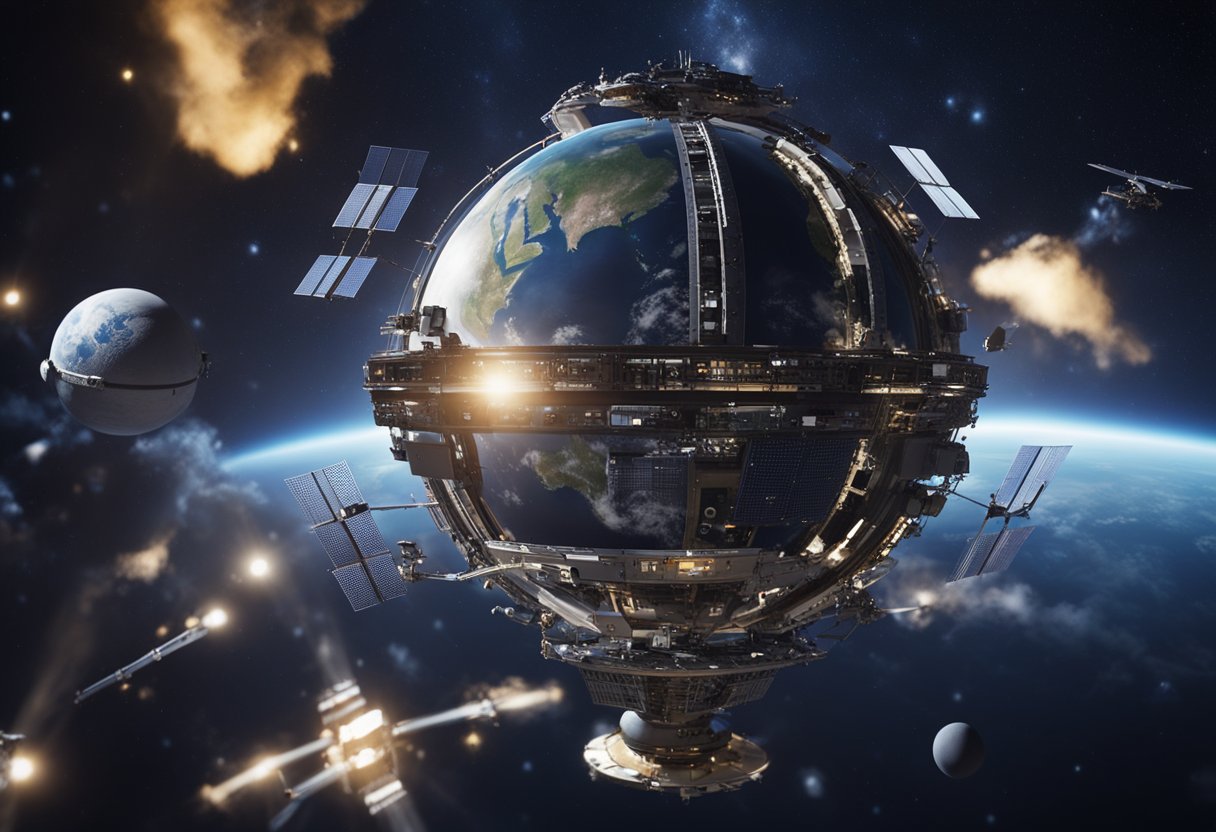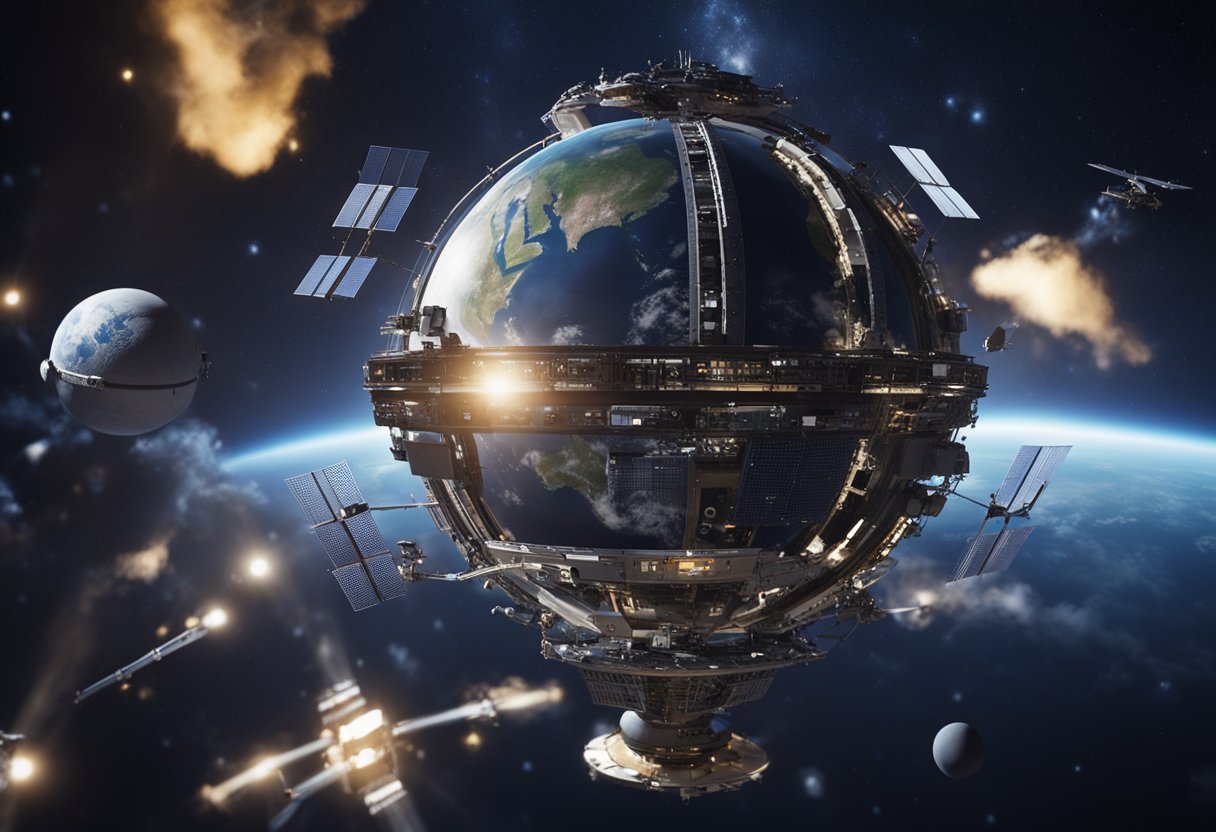
Communication with Earth: Communicating with Earth from space is a complex process that encompasses an intricate network of technologies and infrastructure. As we traverse further into the cosmos, establishing reliable and efficient communication systems between spacecraft and our home planet has become paramount. The initial endeavours in space communication were a foundational step in understanding the vastness of our universe and the challenges associated with long-distance space communications. Today, sophisticated networks ensure that data, voice, and video transmissions can travel to and from the far reaches of space, providing crucial information for mission control and the public.

With advances in modern communication technologies, we’ve developed methods of remaining in constant contact with probes, rovers, and space observatories. This connectivity relies on antennas strategically placed across Earth’s continents and the Deep Space Network, supplementing the tracking and data exchange with spacecraft. Moreover, the challenges we overcome in communication lay the groundwork for future explorations and, potentially, space tourism as envisioned by initiatives like SpaceVoyageVentures.com.
As we broaden our horizons and aim for interplanetary travel, technological innovations continue to shape our ability to manage vast amounts of data from space missions. From enhancing our understanding of the universe to ensuring that future human explorations and space tourists can safely navigate and communicate, the evolution of space communication technology remains central to our success.

In the initial phase of cosmic exploration, we developed technologies that allowed for the first instances of communication between Earth and the vastness of space, each achievement marking a significant milestone in the field.
After the first artificial satellite, Sputnik, was launched by the Soviet Union in 1957, we recognised the importance of reliable communication with spacecraft. NASA, established in 1958, soon became a pioneer in space communication. Our focus was to develop technologies that would allow spacecraft to maintain contact with mission control on Earth. Early on, communication systems relied heavily on radio-frequency signals. These signals are sent to and from spacecraft via antennas on ground stations, allowing for the exchange of telemetry, tracking, and command data. The first successful spacecraft to utilise such radio-based communication was NASA‘s Explorer 1, launched in 1958.
We soon realised that as missions travelled further from Earth, a more sophisticated network was required. This led to the creation of the Deep Space Network (DSN), managed by the Jet Propulsion Laboratory. The DSN was essential for communications with NASA’s deep space missions, including the famous Apollo moon landings. Its large antennas were positioned in Goldstone, Madrid, and Canberra, effectively covering the globe and ensuring continuous communication with spacecraft regardless of Earth’s rotation. The establishment of the DSN represented a monumental step in our ability to send and receive detailed data from distant spaces on an unprecedented scale.
In this section, we’ll explore the innovative strides taken in space communication, which have been pivotal in enhancing our data relay capabilities and ensuring robust connectivity between Earth and various space missions.
One of the most significant leaps in technology we’ve seen is in laser communications. This technique promises a revolution in space communications by providing higher data rates than traditional radio frequency systems. Our understanding of this technology has grown exponentially with the success of the Laser Communications Relay Demonstration (LCRD). This demonstration marks a pivotal point, showcasing how laser communications can enable faster and more reliable transfer of information back to Earth, which is crucial for both scientific and commercial purposes, such as those chronicled on SpaceVoyageVentures.com.
Satellites serve as the backbone of our space communication network. Operating as relay points, these satellites significantly extend the range of communication, allowing us to maintain contact with distant space probes and crewed missions beyond low Earth orbit. Our deployment of such relay satellites, including the LCRD, is key to empowering a new era of exploration, where communication infrastructure is as critical as the spacecraft and missions themselves. These advancements ensure we can send and receive complex data with reliability, turning what once seemed like science fiction into everyday science fact.
In our exploration of space, we deploy sophisticated communication systems onboard spacecraft to maintain a lifeline of data and navigation signals between these complex vehicles and mission control on Earth.
Designing communication hardware for spacecraft is a meticulous task that necessitates a combination of advanced technology and innovative engineering practices. We must ensure that transmitters and receivers are robust enough to handle the vast distances of the solar system, while being sensitive enough to collect the necessary data with high fidelity. This hardware is engineered to withstand the harsh conditions of space, including extreme temperatures and radiation. Engineers frequently select materials and designs that maximise energy efficiency, crucial for operations where solar power may be the primary energy source.
Integrating communication systems with spacecraft involves a careful orchestration between various subsystems. Our onboard transmitters and receivers must interface seamlessly with navigation systems to ensure we can accurately calculate and adjust the trajectory of the spacecraft. The communication technology must also synchronise with onboard data storage units, collecting and sending huge amounts of space science related data back to Earth for analysis. It’s essential that these systems work in unison to provide constant and reliable communication, underpinning the success of our missions across the solar system.
In space communications, precision in transmitting and receiving signals is critical for success. We focus on the characteristics and usage of electromagnetic waves, specifically how varying frequencies and bandwidths play a role in effective satellite communication.
Electromagnetic waves are the backbone of space communication; they carry data across the vastness of space at the speed of light. These waves have different properties, such as wavelength and frequency, which influence how well they can carry signals across the cosmos. For instance, radio waves, with their long wavelengths, are capable of transmitting signals over tremendous distances without too much loss of information.
When discussing frequencies in satellite communication, we’re referring to the specific portion of the spectrum the electromagnetic waves are utilising. Higher frequencies have shorter wavelengths and can carry more data, leading to higher data rates. The bandwidth represents the range of frequencies used to transmit signals; larger bandwidth allows for more data to be sent and received. It is essential to select the appropriate frequency and bandwidth tailored to the mission’s communication needs for optimal performance.
We recognise the pivotal role robust infrastructures play in maintaining communications between Earth and spacecraft. The elements of Earth’s space communication infrastructure serve as vital links for data transmission, operational commands, and scientific discovery.
Ground stations and Earth terminals are strategic installations scattered globally that facilitate communications with satellites and other spacecraft. These stations, equipped with sophisticated antennas and electronic systems, receive and transmit signals to and from space. Notable locations include facilities in Australia, California, and Spain. They form part of an international network that supports various missions, from the Artemis programme aimed at lunar exploration to the myriad of scientific satellites observing Earth.
This network is a complex web of facilities and systems meticulously orchestrated to ensure seamless space communication. The linchpin of this network is the Deep Space Network (DSN), managed by NASA’s Jet Propulsion Laboratory. The DSN consists of three strategically placed communication complexes in:
Each site’s placement ensures that spacecraft remain in contact with Earth regardless of the planet’s rotation.
We ensure that our Space Communications and Navigation (SCAN) program works closely with entities like JPL to keep the infrastructure at the cutting edge of technology.
In maintaining contact with spacecraft venturing far beyond Earth’s orbit, a complex network and cutting-edge technologies are imperative for success.
We encounter profound challenges when attempting to communicate over the vast distances of deep space. Signal delay is a significant concern, as the time taken for a message to travel between Earth and distant spacecraft can extend from minutes to hours. The Deep Space Network (DSN), with its stations in California, Canberra, and Madrid, is crucial in overcoming these obstacles. It provides a continuous line-of-sight to spacecraft, regardless of Earth’s rotation. Moreover, the weak signals received from the likes of Voyager 1, which has voyaged into interstellar space, stretch the limits of current technology due to their diminished strength at such great distances.
Interplanetary communication is managed largely through the DSN, supporting missions such as the Perseverance rover and the Mars Reconnaissance Orbiter around Mars. Innovative techniques such as the Deep Space Optical Communications (DSOC) project aim to revolutionise our capacity to transmit data. This technology, slated to be demonstrated on the upcoming Psyche mission, utilises a near-infrared laser to send signals back to Earth, increasing data rates significantly over the traditional radio frequencies. Missions like Mars Express and Mars Odyssey benefit immensely from these advancements, which promise a new era in information exchange from deep space missions, bringing us closer than ever to the frontiers of the cosmos.
In space communication, precise navigation and accurate timing are critical for ensuring information and data are reliably sent and received among spacecraft within the solar system. These elements are vital for the success of missions.
Accurate timing is paramount for space communication. Our ability to communicate with and navigate spacecraft hinges on synchronised timekeeping systems. For instance, a signal sent from the International Space Station (ISS) to Earth conveys essential data that depends on precise timestamps to correlate with events in terrestrial time. Similarly, communicating with probes en route to planets like Mars, Saturn, Jupiter, or Uranus requires exact timing to ensure that data isn’t lost and navigation commands are received at the intended moment. Even a minor discrepancy in time can lead to errors in trajectory, which over the vast distances of space, can be catastrophic.
Global Positioning Systems (GPS) play a crucial role in the navigation of spacecraft. Though GPS was initially designed for Earth-bound applications, its use has been extended to provide navigation solutions to space vehicles in lower Earth orbits. By using a constellation of satellites that transmit signals indicating their location and the current time, spacecraft equipped with GPS receivers can determine their position and speed with remarkable accuracy. However, as vehicles venture farther into the solar system, alternative navigation methods must be employed. These methods use complex calculations involving the tracking of radio signals sent between the spacecraft and Earth, requiring ultra-precise timing to ensure that the vast distances travelled by the signals do not result in navigation errors.
Our understanding of space navigation and the development of technologies like those documented by NASA’s Lunar Communications and Navigation Architecture supports the aspiration of sites like SpaceVoyageVentures.com, where information about space tourism and exploratory missions is shared with the public, highlighting the progress in making space more accessible.

As we explore the vast reaches of space, the handling of the vast quantities of data sent to and from space missions becomes paramount. These data are instrumental in ensuring the continuous flow of scientific discovery and the safe operation of spacecraft.
Our capabilities for data collection in space largely hinge on a suite of sophisticated instruments onboard spacecraft, such as cameras and sensors, that collect high-resolution images and diverse scientific data. This information is invaluable for advancements in many scientific fields, from astrophysics to Earth science.
The transmission process involves the encoding of data onto electromagnetic waves. These encoded messages are then sent through space at the speed of light, aiming for various receivers on Earth. Advances in space communications technology have led to remarkable improvements in data rates. An example of this is NASA’s Deep Space Optical Communications project, which aims to push the boundaries of data transmission speeds using near-infrared lasers. This technique can increase the amount of data transmitted over vast distances by encoding the information onto a laser beam, a technology that could become widely used by ventures, such as SpaceVoyageVentures.com, in the rapidly developing industry of space tourism.
Once data reaches Earth, it requires processing to convert raw information into a usable format. This involves various protocols specifically designed to handle the latency and energy constraints associated with long-distance space transmission. Our ground-based systems have to be equipped with advanced technology to deal with these challenges, ensuring that data from facilities like the International Space Station can be utilised promptly and effectively.
The analysis of space data utilises state-of-the-art science and technology to decode the wealth of information gathered from missions. Researchers and scientists across the globe collaborate to interpret these data, leading to new discoveries about our universe. The information gleaned from these analyses feeds back into improving both the hardware and software used in space communications, contributing to the evolution of protocols and systems that will manage the data from future missions, including both scientific expeditions and space tourism.
In the expanse of space, effective communication systems are vital for astronauts aboard spacecraft like the International Space Station (ISS) to maintain contact with Earth. These systems ensure the safety and success of space missions through robust technical operations.
Astronauts have various means to converse with mission control centres on Earth. Voice communication is the primary method used for real-time discussions, facilitated by a complex network of satellites and ground stations across different continents. Such an integrated setup ensures that the communications between astronauts and Earth are seamless. When astronauts communicate with Earth, they rely on high-frequency radio waves, which are then captured by the Tracking and Data Relay Satellites (TDRS). These are then relayed to ground stations.
Audio quality must be crystal clear, as these conversations often involve critical mission operations and safety instructions. To ensure uninterruptible communication, provisions for redundancy are built into the systems so that no single point of failure can lead to a complete communication blackout.
For inter-crew communications, astronauts onboard a spacecraft or the ISS use a more localized system, similar to Wi-Fi, to allow for wireless communication. These systems enable them to converse freely within the spacecraft without needing to be physically connected to a communication device. When an astronaut is suited up in a spacesuit, communication becomes more challenging. Each spacesuit is furnished with an audio system that allows for communication with fellow crew members during spacewalks or extra-vehicular activities.
For emergency scenarios or when radio silence is required, astronauts have alternative non-verbal communication protocols in place to relay essential messages. Considering the ambitious projects charted by upcoming space tourism ventures, such as those documented at SpaceVoyageVentures.com, the sophistication and reliability of inter-crew communication systems are ever more crucial. These systems must evolve to accommodate not just astronauts, but soon, the space tourists who will rely on them for safe and effective interactions in space.
Developing these delicate communication links involves a continuous process, iterating on current technologies to ensure humanity remains connected, whether on Earth or orbiting above it.
In the realm of space exploration, communication technologies act as the lifeline between Earth and space missions. The development and advancement of such technologies are crucial for the success of current and future endeavours in the cosmos.
We are witnessing an era where traditional radio frequency (RF) systems are being complemented and, in some cases, surpassed by more advanced optical and laser communications. Our consistent efforts in research are leading to more reliable and higher bandwidth communications. The Laser Communications Relay Demonstration (LCRD) is a testament to these endeavours. It serves as the groundwork for future missions that require robust, high-data-rate communication systems. As we build on the success of such technologies, our capacity to transfer vast amounts of data between Earth and spacecraft will be greatly enhanced.
Optical and laser technologies offer transformative potential for space communications. Compared to traditional RF communications, laser communications provide higher data rates, which are essential for transmitting high-resolution images and videos as well as a wealth of scientific data back to Earth. With the gateway to deep space exploration opening, these optical systems will be instrumental in our endeavour to maintain a seamless flow of communication. By harnessing these technologies, we are developing the capability to support crewed and uncrewed missions with efficiency, paving the way for the future of long-distance space communications.
In our exploration of space, communication remains a pivotal aspect. We unravel the mechanics of space communications systems and explain the integral networks that sustain contact with astronauts and probes beyond Earth’s atmosphere.
Astronauts use radio frequencies to converse with Earth, specifically via the Space Network and Near Earth Network, which provide real-time communication. This system relays signals between spacecraft and ground stations, ensuring constant contact with mission control.
The Deep Space Network is essential for communication with missions far beyond Earth’s orbit. It consists of a series of large antennas located around the world, intended to maintain communication with interplanetary spacecraft.
NASA’s communication satellites form the backbone of our space exploration endeavours. They operate as part of the Space Network, assisting in the relay of signals and data between Earth and spaceborne vehicles, playing a crucial role in navigation and scientific data return.
Long-distance communication across space is enabled through a combination of radio waves and the Space Communications and Navigation networks, which include the Near Earth Network, Space Network, and Deep Space Network. These methods involve sophisticated modulation techniques to encode and transmit data reliably over vast distances.
The time required for a message to travel from Earth to the International Space Station is typically less than a second. This is due to the relatively short distance between the ISS and Earth, approximately 408 km in a low Earth orbit.
The technology that allows the Voyager 1 probe to maintain communication over vast distances from Earth is a highly sensitive and reliable radio communication system. It utilises the Deep Space Network for transmitting and receiving signals, despite the probe being billions of kilometres away from Earth.